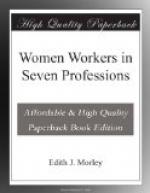Women Telephone Operators are a large and rapidly growing class, recruited entirely by nomination followed by a qualifying examination. They number at the present time about 4,000, including Supervisors. The growing use of the telephone is replacing the telegraph, and is likely to make of this class a serious rival to the grade of Telegraphist. In this connection, it is important to recognise that the change is likely to entail an enormous increase in the use of cheap labour. The maximum salary of the Telephonist in London is only 28s. per week. The work is extremely exacting and exhausting to the nervous system, so much so, that it is an absolute necessity for the maintenance of health that proper and adequate rest-room accommodation should be provided, and that the operators should be equipped with apparatus of the proper type.
The classes already mentioned have, until the present year (1913), been recruited solely for the Post Office, but the class of Women Typists, numbering about 600, are a Treasury Class, and are common to the whole Civil Service, the conditions of entry varying according to the Department. In the Post Office alone, are Typists recruited by open competitive examination. The scale of salary is 20s. a week, rising in three years to 26s.: they then have the option of qualifying in shorthand, after which they can rise to 31s. per week. In the Post Office, however, the number allowed to qualify in this way is limited to 50 per cent. of the staff. The supervising posts are: Superintendent, 35s. a week, and Chief Superintendent, 40s. a week. No higher positions are open to Typists anywhere, no matter how good their qualifications and educational equipment. The Association of Civil Service Typists claim some avenue of promotion to clerical work in the Departments in which they serve.




